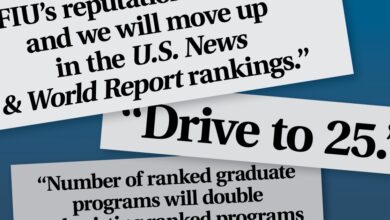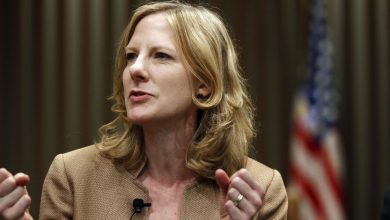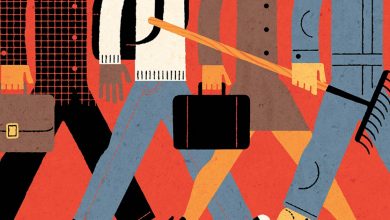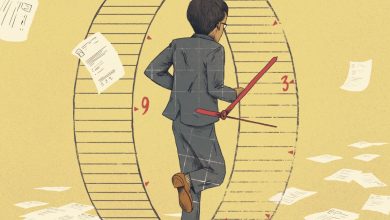The Perilous Predicament of the Very Small College

If there’s a primary vital sign for colleges, a crude point of reference for outside observers, like the pulse of an emergency-room patient, it’s student enrollment. A college with thousands of students is usually a sign of healthy fiscal and reputational footing.
Colleges with 1,000 students or fewer may be headed for intensive care, or worse.
Small comes with inherent challenges. Smaller institutions can’t take advantage of the economies of scale that bigger ones can, and they are overly dependent on each and every student’s tuition dollars. With so little margin for error, sliding enrollment or poor spending decisions can spiral toward insolvency or even closure.
Enrollment at many of these colleges of 1,000 students or fewer was already flagging over recent years, a result of increased competition for the waning number of college-bound high-school graduates. Covid-19 dealt them another shock to the system.
In 2010 there were 395 private, nonprofit four-year colleges with 1,000 students or fewer, according to a Chronicle analysis of enrollment data from the U.S. Department of Education.
In 2020, the most recent year for which federal data were available, there were 435.
There’s no invisible line of peril a college crosses by having 1,000 students or fewer, and no alarm system that alerts accreditors and reporters. But institutions with such small enrollments tend to be among the most financially vulnerable, experts say.
“If you were challenged before Covid and you haven’t figured out how to strengthen your position in the market, you’re going to be challenged even more,” said Nanci Tessier, a principal of Art & Science Group, a consulting company that works with colleges.
Leaders at small colleges say they’ve spent the last year overhauling their academic programs, bolstering their enrollment offices, and expanding their online-learning options to appeal to more nontraditional students.
Mark Roosevelt knows something about running small colleges.
Today he’s president of St. John’s College in Santa Fe, N.M., which, along with its campus in Annapolis, Md., enrolls about 1,000 students over all.
Before coming to St. John’s in 2015, he led Antioch College, a small liberal-arts institution in Yellow Springs, Ohio, that had closed in 2008 because of financial difficulties only to be reopened in 2011 with Roosevelt in charge. Antioch had 116 students in 2020, according to federal data.
Recruiting students to a small and faltering institution “can be hard because students and families sense your precariousness,” he says. “So precariousness sort of yields further precariousness.”
But the federal money is gone, the endowment gold rush is over, and new economic storm clouds are gathering.
Inflation has raised the cost of operating a college , says Robert Kelchen, a professor of higher education at the University of Tennessee at Knoxville and an expert on college finances. The more a small college has to pay for food for its dining hall, or energy to cool and heat its buildings, the more difficult it is for them to afford things like dorm upkeep or bonuses for faculty.
In addition to new economic pressures, the forces that made it challenging to serve the smallest student bodies before the pandemic didn’t go anywhere, and some got worse.
Half of the federal emergency-aid money was earmarked for students, but what small colleges did with the other half could help determine how they fare over the next few years.
“Did they use it to make up for things where they have had shortfalls in the past?” asks Marjorie Haas, president of the Council of Independent Colleges, a membership organization for small, private colleges. “Or did they use it as an investment in things that would help them draw and increase revenue in the future?”
The number of high-school graduates is expected to plunge starting in 2025 because of low birth rates, and college enrollment over all doesn’t appear to be recovering from Covid-19. Data compiled by the National Student Clearinghouse Research Center shows that college enrollment of the high-school class of 2020 declined by nearly 7 percent compared with the class of 2019 despite a similar cohort size.
Fewer students creates an acute challenge for small, private colleges based on inevitable math, says Rick Staisloff, a principal of the rpk Group, a company that consults with colleges.
A tiny liberal-arts college doesn’t have the huge overhead costs of a large university, but it probably doesn’t have the multiple income streams, such as research dollars or athletic income, either.
Microcolleges run on tuition dollars. It may cost less to educate fewer students, but a college can’t scrimp on essential functions: It needs people to teach the classes, it needs someone to handle the finances, it needs a registrar.
“It’s more costly, on a per-student basis, to provide quality higher education” at a small college, Staisloff says, and the fewer students a college has — and the more financial aid it hands out to attract those students in a competitive environment — the fewer tuition dollars it has to pay those costs.
Some institutions have started to raise tuition — considered anathema because of the financial pressures it puts on families — but “they’re not able to increase tuition anywhere near the rate of inflation,” Kelchen says. Some financial pundits fear inflation is pushing the economy toward another recession, if we’re not already in one.
Not every college with fewer than 1,000 students will survive the coming years unscathed. The list of such colleges, compiled by The Chronicle using data from 2020 — the most recent available — includes several institutions that have since closed (e.g. the San Francisco Art Institute) and several others that nearly closed (e.g. Hampshire College). Most if not all of those that close every year come from the microcollege ranks.
But colleges are stubborn and resilient institutions, and there’s unlikely to be an outsized wave of closings, says Kelchen. Devoted alumni have stepped in to save several small institutions in recent years, including Hampshire and Sweet Briar Colleges. But it’s equally unlikely that the steady trickle of closings— about a dozen every year, according to data Kelchen tracks — will stop.
Even as the nation grew, higher education remained a small-scale activity, still based around a few hundred tiny seminaries, agricultural schools, and teachers colleges. In 1869 only about 63,000 students, or about 1 percent of the American population between the ages of 18 and 24, attended college, according to federal data.
But over the course of the 20th century, American higher education expanded with the country’s middle-class prosperity and its technology-driven needs. The University of Florida, for example, enrolled 102 students in its first year, 1906. It now enrolls more than 52,000 students, while the University of Central Florida, its sister campus founded in 1963 in the boomtown of Orlando, enrolls more than 66,000. About 20 million Americans now attend college each year, an increasing number at institutions with vast online operations that enroll more than 100,000 students, like Liberty University.
But the small campus where you know everyone and everyone knows you has never gone away. Small colleges offer an intimate educational setting, and some students seek out their traditional red-brick, grassy-quad residential settings with small classes and a lot of contact with faculty members.
Some types of education mandate a smaller size. Music education depends heavily on personal lessons, for example, so conservatories are often small. Religious colleges are often tied to a particular denomination or sect, limiting their scale. All of those types of institutions show up among the 435 microcolleges in the Department of Education data.
Competing for students in years to come could be especially tough for the smallest colleges, says Nanci Tessier of the Art & Science Group. The traditional-age, first-time, full-time student on whom so many small liberal-arts colleges rely, often look for “a big-college experience,” she says — a broad choice of academic and social experiences to explore. A large institution with hundreds of academic options, thousands of fellow students, and a wide variety of social groups and experiences often appeals more to a 17-year-old than a small college with limited offerings.
Some students prioritize a more intimate college experience, but small colleges don’t have the corner on that market anymore, Tessier said. Big universities have redesigned their freshman experience to offer more personal attention and smaller classes so that students feel they can have a big, expansive undergraduate experience, “and it’s going to be small and personal,” she said, “because I’ll have smaller classes, or I’ll get to know my faculty, or whatnot.”
Distinctiveness can pay off for institutions as well as their students. Students spend their college years at St. John’s College’s two campuses focusing on foundational texts of Western civilization, reading canonical staples like Wordsworth’s epic poem The Prelude and discussing them in small seminars. The “Great Books” curriculum stands in stark contrast to the overtly career-focused education offered by many colleges now, but it appeals to a particular type of student, says Roosevelt, president of the Santa Fe campus.
St. John’s receives relatively few applications each year — about 1,500 for both campuses for the fall of 2022 as of July — compared with many of its peers. But it admits as many as 80 percent of those who apply, and as many as 40 percent of those admitted attend, both high compared with peer institutions.
“Because we’re so rigorous, very few people apply who aren’t serious about coming,” he said. Overall enrollment fell 9 percent in Santa Fe between the fall of 2015 and the fall of 2020, according to federal data, but remained roughly flat in Annapolis. Current total enrollment has climbed to 1,011.
While Roosevelt is conscious of the need to keep the college’s enrollment up, he isn’t interested in growing just for the sake of growth. St. John’s education model is based on students meeting in seminars of fewer than 20 students. Scaling up isn’t an option, even if leaders were interested. “Both of our campuses are around 400 students, and that’s how they work well,” he says. “That’s how they feel right.”
The college’s annual operating budget is around $50 million, and its endowment is around $300 million, with two bequests set to increase it by an additional $90 million in coming years, he says. While its endowment insulates it from the worst financial shocks, he says, the tiny number of applicants each year means “we’re very attentive to the potential of the demographic cliff to hit us.”
Given St. John’s unique model, it’s unlikely to add, say, a nursing program. But the pandemic did provide a serendipitous benefit. Leaders of the college used some of its aid money to help move classes online — never a priority before, given the college’s emphasis on in-person seminars. Graduate enrollment has since nearly doubled, from 48 students in 2019 to 84 in 2021.
But Beloit has suffered in recent years. Enrollment plunged from 1,358 in the fall of 2015 to 978 in the fall of 2020, according to federal data, a drop of 28 percent. Through eliminating or restructuring about 25 staff positions, some faculty buyouts, and reducing the number of adjunct instructors, the college lowered the number of employees at the college by about 18 percent by 2018.
Rather than turn away from the liberal arts, top administrators and faculty met in 2019 to rethink the college’s approach to the curriculum. The college bolstered its advising, linking admitted high-school students to specific faculty members for mentorship within 72 hours of applicants’ committing to the institution. It also reorganized its academic offerings into eight career channels, such as business and entrepreneurship or justice and rights, that connect students with outside-the-classroom activities, and alumni mentors, as well as specific coursework. The college also added a handful of new programs, including data science and business economics. About $11 million in grant and donor dollars helped pay for the reorganization, and the college engaged a marketing firm to help spread the word about the new Beloit.
Covid-19 added more uncertainty to Beloit’s future, but enrollment has stabilized around 1,000 students, and the entering class in the fall of 2021 was 12 percent ahead of goals.
Lake Erie College, a waterside campus in the Cleveland suburbs, has been through its share of small-college woes. It saw its overall enrollment drop from 1,243 in the fall of 2015, according to federal data, to 949 in the fall of 2020, a decrease of 24 percent.
Undergraduate enrollment continued to slide throughout the pandemic, but new graduate programs, including a new master’s degree in professional studies, have buoyed overall enrollment.
Lake Erie’s equestrian teams, and the equestrian-studies program that backs them, represent the kind of niche appeal that may offer the best insurance the smallest colleges have against the most unpredictable forces of the post-pandemic landscape.
Yet equine studies and equestrian teams aren’t silver bullets that will fix any college’s enrollment problems any more than any other particular solution. Horses are expensive to maintain, says Pamela A. Hess, a veterinarian and dean of Lake Erie’s School of Equine Studies. The budget for the equestrian teams, which use about 50 horses, is in the mid-six figures, she says, and Lake Erie now competes for students and riders with several other colleges with equestrian programs, including Otterbein University, outside nearby Columbus, Ohio.
But, Hess adds, the students who come to Lake Erie to ride or major in equestrian studies really want to be there. They are typically well-prepared for college and many come from families of means. “These are the students all colleges want to have in their classes,” she says.
And when the numbers of students are small, small things can make a difference.
Lake Erie’s equestrian team won its regional championship in 2020, and the college’s program is expecting 34 new riders this fall from all over the country, a much larger class than the college has had in recent years.
Source link






